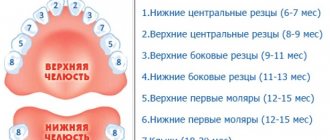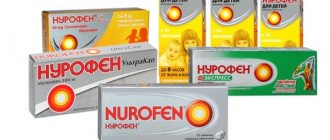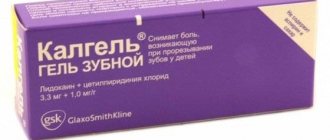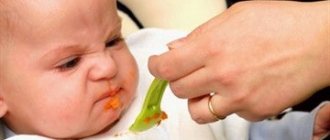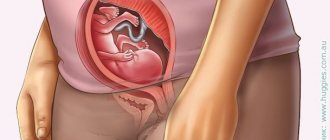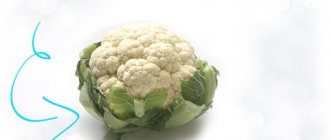Almost all parents know first-hand what teething entails. This is a painful process that torments the baby. He becomes overly moody and begins to have difficulty sleeping. Very often, parents attribute all their child’s sleep disturbances to teeth, even if they last for several months.
What signs indicate that your baby is actually teething?
- Excessive salivation means that it is more abundant than usual;
- Runny nose - typical symptoms of a cold may be caused by teething rather than viruses;
- Refusal to eat or, conversely, the baby literally “hangs” on the chest all day;
- The desire to suck or chew everything;
- Swollen gums;
- Restless, interrupted sleep, problems falling asleep;
- Moody mood during the day.
I would like to note that your child does not necessarily have all these signs. Some people have absolutely all the symptoms, while others have none. Each baby is individual, don't forget about it.
Teething lasts on average from two to five days, with a maximum of seven.
Therefore, you should not blame long-term sleep disturbances on your teeth. When teething, the child usually does not sleep or sleeps poorly at night. During the day he has many distractions, and at night it is dark and quiet, the pain comes to the fore.
How to understand that your child is not sleeping well because he is teething:
- The sleep disturbances happened suddenly. If your baby has always slept well, but one night he starts waking up and screaming very often, check his mouth. At the same time, rule out all other causes of poor sleep.
- Bad mood during the day. As we wrote earlier, the baby may not show any signs of teething. But if the pain causes him severe discomfort and affects his sleep at night, it will make itself felt during the day.
- After taking the medicine it becomes easier. Be sure to consult with your doctor which medications and in what dosage can be given to your baby during teething. If after using them, the child sleeps soundly, then his teeth have disturbed his sleep.
The most important advice that can be given is to be patient! One way or another, all the teeth will come out and sleepless nights will pass. You can help your baby survive this time in a variety of ways - water teethers (keep them in the refrigerator), special toothbrushes, various toys. Try all the options, one of them may suit you.
Ask your doctor, he will advise you on various medications to relieve the condition.
Tatiana Kremneva.
Baby teething
In some babies, the first incisors form unnoticed, without causing any discomfort, and parents notice them when they have already formed and become visible. For other children, this process fully corresponds to the word “cutting through.” Incisors, canines or molars begin to grow from the jawbone. As they increase in size, they cut the soft tissue of the gums, and the child does not sleep at night because of the teeth.
Signs of teething
The formation of a new tooth lasts from one day to five days. The process of formation of the entire oral cavity can last about two years. The most severe pain and anxiety of the child is observed when the first 3-5 incisors and the last molars grow.
All signs of the formation of dental bones can be divided into two types:
Visual:
- Your baby's cheeks may develop a rash.
- A large amount of saliva secreted is smeared with hands over the cheeks and chin. The child constantly puts his hands in his mouth.
- The gums become swollen and red. In places where teeth appear, a layer of dying muscle tissue forms, which has a whitish tint.
- Due to the entry of a large amount of salivary fluid into the gastrointestinal tract, diarrhea may begin.
- The process is sometimes accompanied by an increase in temperature.
Behavioral:
- Because The tooth grows through the gum, which is accompanied by itching and pain. The child begins to put everything that comes into his hands into his mouth.
- Due to the development of the chewing reflex, the baby may bite the breast nipple hard and painfully during feeding.
- While awake, it is easier for the baby to distract himself from all the sensations that growing teeth give him. During sleep, he completely concentrates on them, and therefore it is harder for him to fall asleep and lie still.
If the baby is about six months old and has any of the above, then you should look for the reason in the mouth. In most children, such problems appear only at night, when teething causes the infant to have difficulty sleeping.
The baby's sleep is restless, he often wakes up, cries and sometimes even screams for a long time. The most unpleasant thing for parents is that this happens both during the day and at night.
How to distinguish teething from just bad sleep
If the baby is at the stage of teething, and before that he slept well, and there were no violations of the regime, then you should pay attention to his gums. You should at least carefully probe them.
During such a period, the little man does not leave his hands during the day, is capricious a lot, puts everything in his mouth, and does not eat well. Disturbance in night sleep in this case will be a continuation of daytime restlessness and the reason for this is the growth of new bones in the mouth.
How to understand that a high temperature is caused by teething
Starting from the age of six months, if there are no visible signs of colds or other diseases (the stomach is fine, the baby poops well, etc.), the child’s temperature may rise due to teeth cutting.
Increasing in size, the dental bone begins to push apart the muscle tissue, and this can be accompanied by inflammatory processes and lead to an increase in body temperature. Carefully examine your baby's mouth. Frequent temperature fluctuations can occur when several teeth erupt at once.
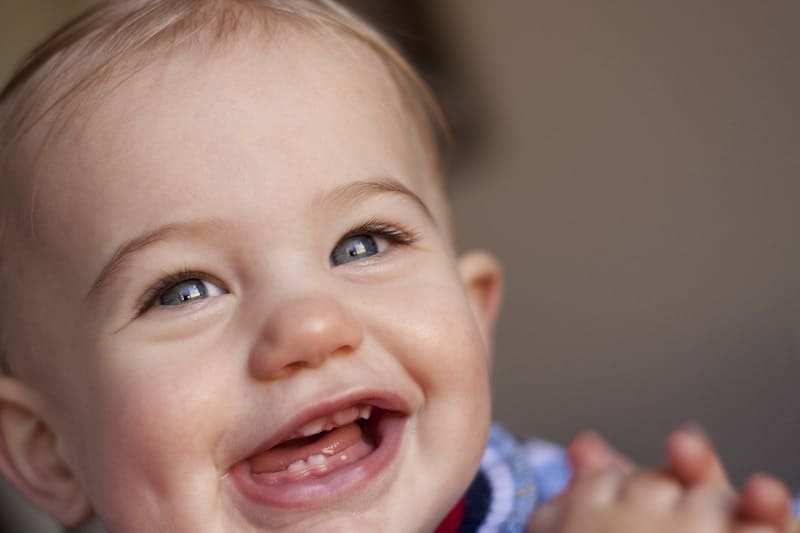
How to help your child relieve pain
Young mothers often ask when teeth are cutting what to do. The simplest and most effective remedy is special hollow devices made of medical silicone and filled from the inside with plain water. The baby can calmly squeeze them with his itchy jaws.
Before giving such a “gnaw” to a child, you should keep it in the refrigerator. Then such a thing will not only help scratch the gums, but also cool them, while reducing the pain that makes the baby suffer. Such toys are freely sold at any pharmacy, along with pacifiers and feeding bottles.
Among medications (during this period), it is recommended to use special painkillers for children, which are used to lubricate inflamed gums.
These include:
- Paracetamol;
- Ibuprofen;
- Kalgel;
- Holisal;
- Dontinorm Baby;
- Viburcol;
- Dentinox.
When using any drug, you must consult with the doctor who is caring for the baby and carefully read the instructions. The medicine may not immediately suit the baby - you will have to choose something that works more effectively.

Signs
If the baby has good immunity and rarely gets sick, then the process of cutting the first tooth will probably be painless, although the appearance of other symptoms is not excluded . These include:
- redness, swelling of the gums;
- rash in the mouth;
- excessive salivation;
- the child puts everything in his mouth and scratches his gums;
- loss of appetite;
- vomit;
- tearfulness, irritability;
- temperature increase;
- worsening sleep;
- constipation;
- diarrhea;
- nasal congestion, runny nose;
- cough;
- diathesis;
- sour breath;
- cheeks become swollen.
As a rule, the signs of teething are identical in many cases, but there are individual characteristics of a child’s reaction to the appearance of baby teeth.

Redness and swelling of the gums
Redness of the gums is a standard sign that your baby’s tooth is about to come out. Sometimes a slight swelling may appear at the site of the intended incisor.
This is explained by the fact that the area where the future tooth will be located is abundantly supplied with blood and there are active processes of tooth growth through bone tissue and mucous membrane. Due to them, the gums become red.
Puts everything in your mouth and scratches your gums
Itching in the gum tissue is a common occurrence during teething. To alleviate this symptom, the baby constantly puts everything in his mouth and bites, which concerns, first of all, his dirty little hands. Small teethers can help in this case.

Excessive salivation
This sign is the most common reason why a baby starts coughing when lying on his back. In addition, the baby has not yet learned to cope with the copious contents in the mouth, since he does not have the ability to regulate the contents of saliva, as adults do.
The only thing a mother can do in this case is to avoid irritation of the baby’s skin around the mouth if she promptly wipes away the baby’s drool.
Tearfulness and irritability
Another symptom most characteristic of this period is that the child becomes capricious, often cries and gets irritated for any reason.
This is a natural reaction of the baby to the teething process, causing pain and discomfort. A similar symptom appears at night during sleep.
How to improve your baby's sleep
Rest plays an important role in a child's life. When the oral cavity is forming and teeth are coming in, the child does not sleep at night. Parents simply need to do everything to ensure that the baby calms down and at least falls asleep.
During this period, you need to increase your attention to him, hold him in your arms more, come up with new fun and games to distract him from the pain. Before a night's rest, you can give your baby tea with mint, lemon balm, and chamomile, and 15-20 minutes before bedtime, you should lubricate the baby's gums with painkillers.
During this period, babies' sleep is influenced by the behavior of their parents. It is necessary to stock up on endurance and equanimity. The calmer the adults are, the easier and faster the child will endure the stage of teeth formation.
Teething order
Most often, the order in which baby teeth erupt is as follows:
- lower central incisors;
- upper central incisors;
- upper lateral incisors;
- lower lateral incisors;
- first lower and upper molars;
- lower and upper canines;
- second upper and lower molars.
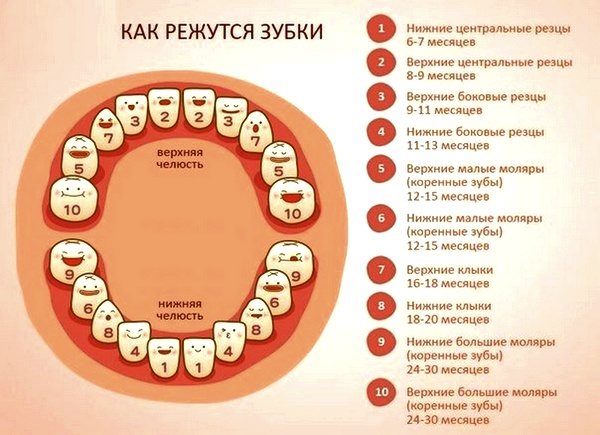
If the first teeth to appear are the upper central incisors, there is no need to worry. This refers to the normal variant. However, this order does not always occur. For example, the canine may erupt simultaneously with the first molar or a little earlier than it, the lower lateral incisor may appear along with the first molar or even a little later.
Advice from Dr. Komarovsky

One of the leading pediatricians, trusted by most of the population, advises parents not to worry and behave calmly if the child does not sleep due to teeth. He strongly urges not to set any rules for your baby.
According to Dr. Komarovsky, parents need to be more restrained. At this age, the child communicates with his parents on a subconscious level. The more calm and friendly the adults, the easier it will be for the baby.
It is necessary to resort to medications only as a last resort, more often using natural remedies, toys that can be chewed, and various herbal drinks and decoctions. You need to massage your gums with special brushes.
Teeth formation is a natural physiological process that everyone goes through. You need to be calm and let the child deal with it on his own.
WHO recommendations
A baby should receive its first food at 6 months, as WHO recommends for mothers. But what is a rule without an exception?
Alla Vladimirovna Dmitrieva, by the way, a doctor of medical sciences, believes that once a baby has teeth, then complementary foods should appear, a tooth appears at 4 or 5 months, which means it should start eating, otherwise what is it for a person.
Alla Vladimirovna does not make an exception for infants who are breastfed by their mother, no matter the amount of mother’s milk, even if it is in excess.
When a baby is teething, his need for protein increases significantly. Therefore, complementary foods should also contain protein. So, for example, as soon as mommy notices that the baby doll has cut a tooth, you can give him half a spoonful of yogurt, gradually increasing the dose.

When the child gets used to liquid yogurt, you can start trying liquid curd.
Other specialists regarding teeth and complementary feeding. Since every mother knows that complementary foods, or rather new foods, are only allowed to be introduced to healthy babies, this means that at the moment of teething, feeding with new delicacies is prohibited.
Interestingly, there are pediatricians who believe that teething is an integral physiological process in the child’s body, indicating that the baby doll is growing and developing, and, therefore, what kind of disease we are talking about.
Therefore, mommies, it’s up to you to decide for yourself how you feel about the appearance of teeth as a disease or as a matter of physiology, based on this, and make a decision.
If we talk about what advice moms gave on forums (and the answers were not only funny, but also dangerous), then you can write a separate article or even a book about this. By the way, if you have your own opinion on the topic, do not hesitate to express it.
How to help your child
First of all, the child during this period needs additional affection and love, because he suffers and needs even more warmth from loved ones. Try to mentally prepare yourself that your child will behave more capriciously and sleep worse at night, but don’t be angry with him for this.
There are special gels that relieve pain, relieve inflammation, and have a cooling effect:
- Dentinox;
- Kalgel;
- Kamistad.
It is also a good idea to use all kinds of teethers . It’s good if they can be cooled and given to the baby.
However, often special devices are not to the child’s liking, then you can use the usual means at hand: crackers, dryers, a crust of bread. Often the child himself chooses his favorite subject. This could be some kind of toy or household item. In this case, it is important to keep it clean.
Remedies for pain relief in children
It is painful for parents to see their child in pain. You can help him get some relief with these remedies:
- Often, pain in the gums is relieved by gentle pressure on them. Therefore, many experts advise gently rubbing the gums with a clean finger or letting the child bite on a clean cloth.
- If pain is causing feeding problems, sometimes a different shaped nipple or using a cup can reduce discomfort and improve feeding.
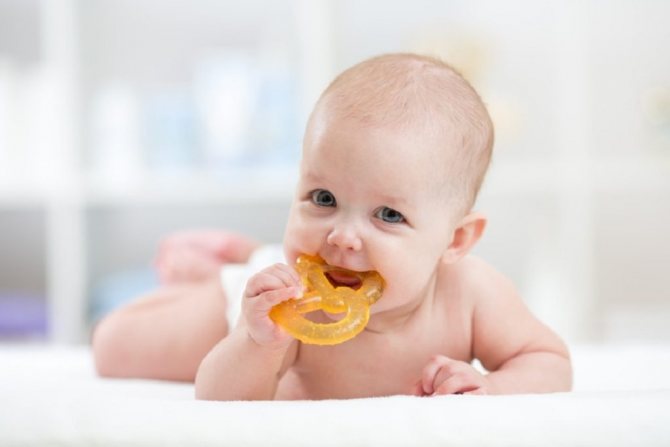
- Cold objects can also help reduce inflammation. Using special teething rings can be helpful. Experienced parents have found that using a cool, damp sponge, a cold pacifier, a spoon, or frozen bananas can be effective in reducing discomfort. Avoid prolonged contact of excessively cold objects with your gums. Also, never place objects that may cause choking (small parts) into your child's mouth.
- Use of painkillers. There is controversy surrounding the use of these products during teething:
- Although some parents approve of topical medications, studies have not always shown their benefit. In May 2011, the FDA issued a warning to avoid topical medications containing an anesthetic called benzocaine. Benzocaine is the main ingredient found in many over-the-counter gels and sprays. The FDA warning indicates a link to a rare but extremely dangerous complication called methemoglobinemia. In this condition, the ability of red blood cells to deliver oxygen throughout the body is significantly limited, which can lead to serious consequences and even death. Children with methemoglobinemia experience pallor, shortness of breath, and increased heart rate. This reaction may occur on first use or after several exposures to benzocaine. A child with these symptoms should be taken to the emergency department of the nearest hospital;
- Systemic medications such as paracetamol or ibuprofen will also help with pain. Check with your pediatrician regarding the use of these and other medications. Care should be taken not to overdo them in their use. The medicine may mask important symptoms that may be necessary to understand the child’s condition;
- Homeopathic remedies and other folk methods are widely used, there is limited research into their true effectiveness. Using clove oil, licorice sticks, fennel, scallions, olive oil, ginger root and chamomile can be effective.
Mechanical methods of assistance
Toys that come in handy are teething toys that are filled with a special gel or liquid. They must be cooled before use.
Bottles or pacifiers with high-quality silicone nipples will come to the rescue.
You can use silicone brushes that fit on your finger. This attachment is used to massage and clean teeth.
Pieces of fruit (apple or pear), dried fruit, crackers, hard cheese, which can be placed in a special device - a nibbler, equipped with a mesh bag for pieces of food. During the process of “salting,” the pieces are turned into puree and are successfully eaten by the baby.
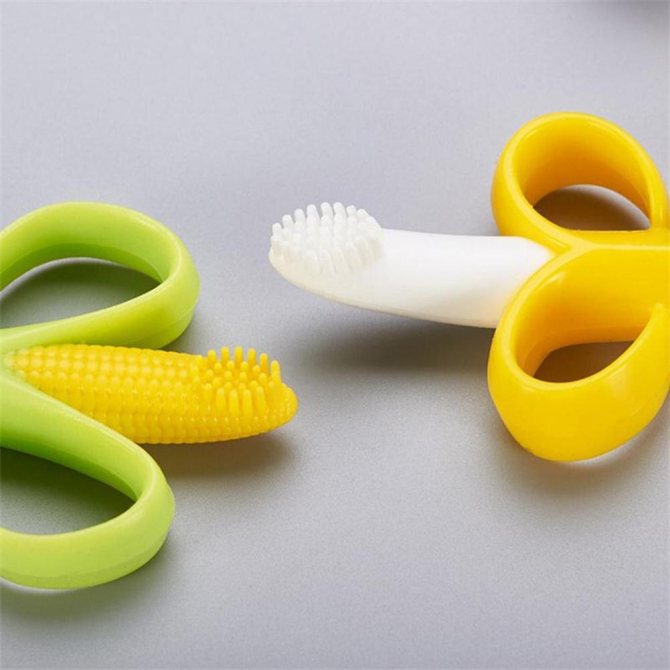
Silicone teething brushes
What can't you do?
- Press on the gum in order to squeeze it out as quickly as possible;
- Pick (pierce and cut) the place where the tooth appears;
- Use alcohol-containing solutions to treat gums.
These manipulations will lead to gum injury and can cause infection.
After teeth appear, it is necessary to take care of them and show them to the pediatric dentist. He will assess the condition of your gums, examine emerging teeth and give recommendations on how to care for them. You can also start eating adult food, because from the moment the first tooth appears and the child reaches 6 months, complementary foods can be introduced. Recommendations on proper nutrition and tips on how to reduce the risk of caries on “new” teeth can be obtained from your dentist.
